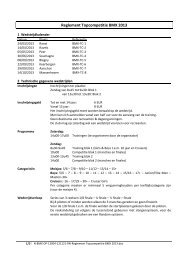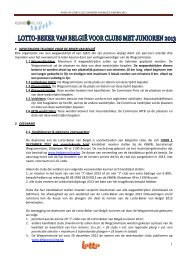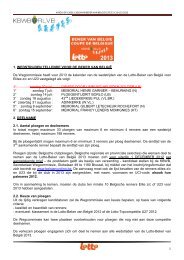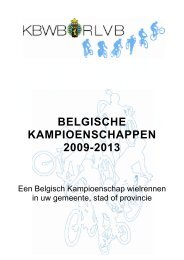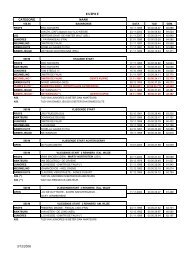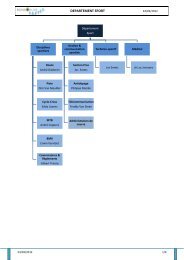Practical guide for organising mountain bike events - UCI
Practical guide for organising mountain bike events - UCI
Practical guide for organising mountain bike events - UCI
You also want an ePaper? Increase the reach of your titles
YUMPU automatically turns print PDFs into web optimized ePapers that Google loves.
<strong>Practical</strong> <strong>guide</strong> <strong>for</strong> <strong>organising</strong> hc | c1 | c2 | c3 <strong>mountain</strong> <strong>bike</strong> <strong>events</strong><strong>Practical</strong> <strong>guide</strong> <strong>for</strong> <strong>organising</strong> hc | c1 | c2 | c3 <strong>mountain</strong> <strong>bike</strong> <strong>events</strong>2104 Events4.1 Arrangements which apply to all the <strong>events</strong>• General in<strong>for</strong>mationProvide backup solutions, because a course which is impassable if the weather is bad is synonymous with failure.Do not underestimate the need to prepare alternative routes which must be passable in any weather.Take all the necessary steps in terms of insurance.Test the equipment and the security systems be<strong>for</strong>e the event.• Regulating the movement of spectatorsThink carefully about the system as regards the start area/finishing zone, and at crossing points on the course.Also ensure that the accreditation system (if there is one in place) is mastered and respected by the staff.• Course mapA map must be made <strong>for</strong> each circuit. The maps are made available to the Commissaires Panel, the teams and thegeneral public via the electronic bulletin board, the official programme.Each map must provide the following in<strong>for</strong>mation:– Course, with the distances every kilometre and overall;– Start area/ finishing zone(s);– Technical assistance / refreshments zone(s);– Profile of the course (maximum and minimum altitudes, distance per lap);– Best viewpoints, names of the most interesting sections of the course;– First-aid posts;– Access roads <strong>for</strong> the spectators;– Bridges, footbridges or <strong>for</strong>ds;– Mechanical ascending aidsTheir specific responsibilities, which change according to the type of event, consist of:– Ensuring that the spectators remain within the specified zones outside the course.– Helping spectators to cross the course;– Ensuring that medical assistance is provided if necessary ;– In<strong>for</strong>ming the riders of accidents and/or dangers;– Carrying out necessary repairs as soon as possible (marker poles, safety tape, etc.);– Pointing out any unfair conduct, any failure to follow the route and any other serious offence (this in<strong>for</strong>mation isconsidered confidential and must only be discussed with the Marshals Coordinator, the President of the CommissairesPanel or another member of the Commissaires Panel when the incident occurs or as soon as possibleafterwards);– Noting down any offence committed by the riders;– Helping the media to work in the most professional and safest conditions possible.You must provide them with:– A list of the accreditations allowing them to access the different sectors;– A first aid map;– A radio or walkie-talkies (if necessary);– A whistle;– Repair equipment (safety tape, spare marker poles, «colsons» = plastic jubilee clips, etc.);– Food and beverages <strong>for</strong> the day;– Bin bags <strong>for</strong> cleaning their sector at the end of the day;– Flags (red and yellow <strong>for</strong> the downhill, yellow <strong>for</strong> the cross-country);– Paper and pencils <strong>for</strong> taking notes relating to incidents.Do not <strong>for</strong>get that they are outside <strong>for</strong> a very long time, generally in <strong>mountain</strong>ous areas, where the weather can changerapidly. Advise them to take a sleeping bag or a bag containing everything they need, including a jacket, a raincoat, sunprotection, etc.11• Map <strong>for</strong> <strong>organising</strong> first-aidAn essential map <strong>for</strong> the organiser, first-aiders and marshals. It must show:– Course, with the distances every kilometre and overall;– Precise location (numbered) of the marshals and of each first aid post ;– Where the red flags are <strong>for</strong> the downhill;– Access roads <strong>for</strong> first aid vehicles;– «Landing area» <strong>for</strong> the helicopter;– Start area / finishing zone;– Technical assistance /refreshments zoneA map of this kind can be found on page 17.All marshals must be at least 18 years old and must be capable of communicating in English or in French at strategicpoints.For maximum security, marshals, in collaboration with the President of the Commissaires Panel, must be briefed on themorning of the event by the Race Manager or the chief marshal <strong>for</strong> the purpose of giving final instructions. Remindthem of how to react when faced with the different situations which may arise.• Inflatable archBe careful! For safety reasons, inflatable arches cannot be placed above the course but only alongside it. A newArticle in the rules stipulates this specific point:• Map <strong>for</strong> the mediaThe better the conditions offered to the media are, the greater theirsatisfaction. Provide a very detailed map of the circuit showing:– The best places <strong>for</strong> filming and <strong>for</strong> taking photos;– Short cuts which can be used between different points on thecircuit;– Press room• MarshalsThe marshals are extremely important <strong>for</strong> an event. They are themain point of contact between the general public and the event.They must be recognizable and must be able to be easily identifiedby wearing a distinctive uni<strong>for</strong>m. They are important ambassadors<strong>for</strong> the discipline and their dealings with the general public and thepress will be remembered by each and every person once the eventhas ended.4.1.040 Inflatable arches crossing the circuit are prohibited.An inflatable arch will be able to be used to indicate the starting line if, and only if, the starting line is outside the circuit.4.2 Cross-country Olympic (XCO)• Presentation of the disciplineCross-country has been an Olympic discipline since 1996. It is an endurance sport where strength, an ability to acceleratequickly and technique are put to the test. Competitions last approximately 2 hours.4.2.001 The duration of cross-country Olympic <strong>for</strong>mat races shall lie within the following ranges or as close aspossible to them (in hours and minutes).



